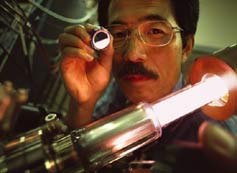

Tuesday - March 28, 2006
SLAC Today is available online at:
http://today.slac.stanford.edu
In this issue:
ILC Innovation: Improving the Photocathode
Safety Today: SLAC Employee and Medical Personnel Save A Life
Terry Anderson Publishes Article in the Liberty County Times
symmetry: The Beauty of Super-K
 |
 |
|
Tuesday - March 28, 2006 |

SLAC's Takashi Maruyama holds one of his cathodes. Image courtesy of Peter Ginter. ILC Innovation: Improving the PhotocathodeWhen built, the International Linear Collider (ILC) will generate one of the world's highest energy electron beams. And it will all start with an electron source called a cathode. This source releases the electrons when hit by laser and is the size of a nickel. SLAC physicist Takashi Maruyama has spent twenty years studying photocathodes and is now working on one for the ILC. Using an innovative design for these crucial wafers, he has greatly increased their efficiency. The ILC will require a high energy beam that is polarized, meaning that the electrons must all spin in the same direction. Photocathodes are made of gallium arsenide, a semiconductor grown as a crystal. By itself, gallium arsenide polarizes a beam at about 50 percent. In 1991, Maruyama and his collaborators increased the polarization to 80%. For certain measurements, the improved polarization even allowed SLAC detectors to outperform CERN's LEP, which had 30 times more events. For the ILC, Maruyama is challenged to reach even higher polarization. Read more... |
||||||||||||||||||||||||||
|
|
||||||||||||||||||||||||||

SLAC Employee and Medical Personnel
|
symmetry: The Beauty of Super-K
Recently I discovered that one of the most beautiful expressions of Japanese craftsmanship is neither a vase in a Tokyo museum nor a carving in a Kyoto temple. Instead, it rests deep inside a mountain in the Japanese Alps. Its beauty is a side effect of its design as its purpose is not intentionally aesthetic, although its intended targets are themselves arguably rather lovely. This giant, liquid extension of human vision, a Cherenkov detector in search of ubiquitous, elusive neutrinos, is like many finely made things the result of thousands of hours of human labor. Read more in symmetry... Terry Anderson Publishes Article in the Liberty County Times
Graphic Designer Terry Anderson has published an article in the Liberty County Times, a local paper near his hometown. The article describes his family history and the people of the region. |
Events (see all | submit)
Announcements
|
||||||||||||||||||||||||
| | ||||||||||||||||||||||||||
What's Cookin' at the Linear Cafe (see weekly menu)
|
||||||||||||||||||||||||||
|
|
||||||||||||||||||||||||||
 <%
Response.AddHeader "Last-modified", getArticleDate()
'Response.AddHeader "Last-modified","Mon, 01 Sep 1997 01:03:33 GMT"
'Monday, December 06, 2010
%>
<%
Response.AddHeader "Last-modified", getArticleDate()
'Response.AddHeader "Last-modified","Mon, 01 Sep 1997 01:03:33 GMT"
'Monday, December 06, 2010
%>View online at http://today.slac.stanford.edu/ |
||||||||||||||||||||||||||